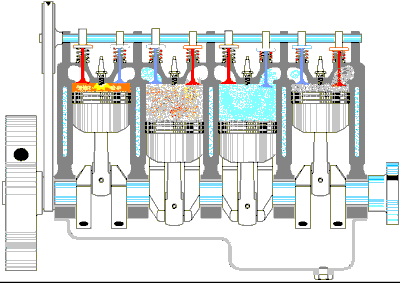The most common type of car engine is an internal combustion gasoline engine working on the principal of the Otto cycle. The simple animation below provides a rough illustration of what is happening in the 4 cylinders of a standard gas motor.

If you analyze the animation then you will see the basic principle of operation which consists of 4 steps performed in each of the cylinders. These are:
1. A fuel air mixture is pulled into a cylinder (where fuel usually enters through a special fuel injector). In the illustration above, the mixture enters through the blue intake valve.
2. The cylinder is then sealed off with both the intake and outlet valves closed and the piston moves upward to compress the mixture required for effective combustion.
3. A spark is then generated by a special spark plug and the mixture is ignited with the burning gas pressure pushing the piston down. This generates power to rotate the crankshaft inside the engine block.
4. Finally, the exhaust valve opens and the piston moves upward to release the exhaust gasses.
This process is continuously repeated in all 4 cylinders while the engine is running. The 4 stokes are also known as: 1. Intake stroke. 2. Compression stroke. 3. Power stroke. 4. Exhaust stroke.
Below is a more detailed animation of a cylinder/valve/piston operation:

Depending on the particular engine design there can be several cylinders-pistons in a car engine (usually there are 4-12). A special connecting rod links the pistons to a crankshaft which is rotated inside the engine block. The crank is used to convert the linear piston motion to rotation.
The following video provides a very good explanation to some of the basics behind the car engine operating principles:
http://www.carsensation.com

cool!
BalasHapus